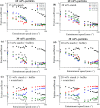Emulsion Microgel Particles as High-Performance Bio-Lubricants
- PMID: 30036468
- PMCID: PMC6096451
- DOI: 10.1021/acsami.8b07883
Emulsion Microgel Particles as High-Performance Bio-Lubricants
Abstract
Starch-based emulsion microgel particles with different starch (15 and 20 wt %) and oil contents (0-15 wt %) were synthesized, and their lubrication performance under physiological conditions was investigated. Emulsion microgels were subjected to skin mimicking or oral cavity mimicking conditions, i.e., smooth hydrophobic polydimethylsiloxane ball-on-disc tribological tests, in the absence or presence of salivary enzyme (α-amylase). In the absence of enzyme, emulsion microgel particles (30-60 vol % particle content) conserved the lubricating properties of emulsion droplets, providing considerably lower friction coefficients (μ ≤ 0.1) in the mixed lubrication regime compared to plain microgel particles (0 wt % oil). Upon addition of enzyme, the lubrication performance of emulsion microgel particles became strongly dependent on the particles' oil content. Microgel particles encapsulating 5-10 wt % oil showed a double plateau mixed lubrication regime having a lowest friction coefficient μ ∼ 0.03 and highest μ ∼ 0.1, the latter higher than with plain microgel particles. An oil content of 15 wt % was necessary for the microgel particles to lubricate similarly to the emulsion droplets, where both systems showed a normal mixed lubrication regime with μ ≤ 0.03. The observed trends in tribology, theoretical considerations, and the combined results of rheology, light scattering, and confocal fluorescence microscopy suggested that the mechanism behind the low friction coefficients was a synergistic enzyme- and shear-triggered release of the emulsion droplets, improving lubrication. The present work thus demonstrates experimentally and theoretically a novel biolubricant additive with stimuli-responsive properties capable of providing efficient boundary lubrication between soft polymeric surfaces. At the same time, the additive should provide an effective delivery vehicle for oil soluble ingredients in aqueous media. These findings demonstrate that emulsion microgel particles can be developed into multifunctional biolubricant additives for future use in numerous soft matter applications where both lubrication and controlled release of bioactives are essential.
Keywords: biological enzymes; biolubricant; colloidal stability; encapsulation; friction reduction; lubricant additives; microgel; soft tribology.
Conflict of interest statement
The authors declare no competing financial interest.
Figures









Similar articles
-
Aqueous Lubrication, Structure and Rheological Properties of Whey Protein Microgel Particles.Langmuir. 2017 Dec 26;33(51):14699-14708. doi: 10.1021/acs.langmuir.7b03627. Epub 2017 Dec 13. Langmuir. 2017. PMID: 29193975
-
Friction reduction and viscosity modification of cellulose nanocrystals as biolubricant additives in polyalphaolefin oil.Carbohydr Polym. 2019 Sep 15;220:228-235. doi: 10.1016/j.carbpol.2019.05.072. Epub 2019 May 28. Carbohydr Polym. 2019. PMID: 31196545
-
Novel starch based emulsion gels and emulsion microgel particles: Design, structure and rheology.Carbohydr Polym. 2017 Dec 15;178:86-94. doi: 10.1016/j.carbpol.2017.09.027. Epub 2017 Sep 11. Carbohydr Polym. 2017. PMID: 29050619
-
Tribology and its growing use toward the study of food oral processing and sensory perception.J Texture Stud. 2020 Feb;51(1):7-22. doi: 10.1111/jtxs.12452. Epub 2019 Jun 19. J Texture Stud. 2020. PMID: 31149733 Review.
-
Microgel particles at the fluid-fluid interfaces.Nanoscale. 2013 Feb 21;5(4):1399-410. doi: 10.1039/c2nr33503d. Nanoscale. 2013. PMID: 23334368 Review.
Cited by
-
3D Biomimetic Tongue-Emulating Surfaces for Tribological Applications.ACS Appl Mater Interfaces. 2020 Nov 4;12(44):49371-49385. doi: 10.1021/acsami.0c12925. Epub 2020 Oct 26. ACS Appl Mater Interfaces. 2020. PMID: 33105986 Free PMC article.
-
Rheology and tribology of starch + κ-carrageenan mixtures.J Texture Stud. 2021 Feb;52(1):16-24. doi: 10.1111/jtxs.12570. Epub 2020 Nov 21. J Texture Stud. 2021. PMID: 33174217 Free PMC article.
-
Role of Flaxseed Gum and Whey Protein Microparticles in Formulating Low-Fat Model Mayonnaises.Foods. 2022 Jan 21;11(3):282. doi: 10.3390/foods11030282. Foods. 2022. PMID: 35159434 Free PMC article.
-
Transforming sustainable plant proteins into high performance lubricating microgels.Nat Commun. 2023 Aug 7;14(1):4743. doi: 10.1038/s41467-023-40414-7. Nat Commun. 2023. PMID: 37550321 Free PMC article.
-
Oral tribology of dairy protein-rich emulsions and emulsion-filled gels affected by colloidal processing and composition.Curr Res Food Sci. 2024 Jul 14;9:100806. doi: 10.1016/j.crfs.2024.100806. eCollection 2024. Curr Res Food Sci. 2024. PMID: 39149526 Free PMC article.
References
-
- Sterner O.; Karageorgaki C.; Zürcher M.; Zürcher S.; Scales C. W.; Fadli Z.; Spencer N. D.; Tosatti S. G. P. Reducing Friction in the Eye: A Comparative Study of Lubrication by Surface-Anchored Synthetic and Natural Ocular Mucin Analogues. ACS Appl. Mater. Interfaces 2017, 9 (23), 20150–20160. 10.1021/acsami.6b16425. - DOI - PubMed
-
- Timm K.; Myant C.; Spikes H. A.; Grunze M. Particulate Lubricants in Cosmetic Applications. Tribol. Int. 2011, 44 (12), 1695–1703. 10.1016/j.triboint.2011.06.017. - DOI
-
- Røn T.; Chronakis I.; Lee S. Polymer 2014, 55, 5708–5717. 10.1016/j.polymer.2014.08.068. - DOI
MeSH terms
Substances
LinkOut - more resources
Full Text Sources
Other Literature Sources
Research Materials

